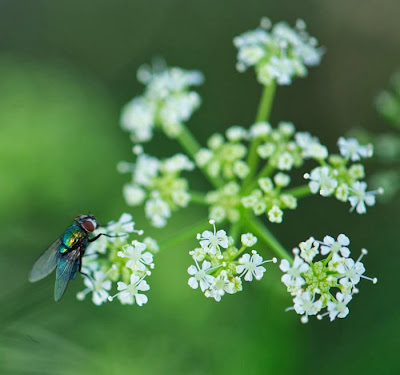Type of Flower
Conium:
Conium is a genus of one or two species of highly poisonous perennial herbaceous flowering plants in the family Apiaceae, native to Europe and the Mediterranean region as Conium maculatum (known popularly as Hemlock), and to southern Africa as Conium chaerophylloides.
By far the more familiar species is Conium maculatum (Hemlock or Poison Hemlock). It is a herbaceous biennial plant that grows between 1.5–2.5 metres (5–8 ft) tall, with a smooth green stem, usually spotted or streaked with red or purple on the lower half of the stem. The leaves are finely divided and lacy, overall triangular in shape, up to 50 centimetres (20 in) long and 40 centimetres (16 in) broad. The flowers are small, white, clustered in umbels up to 10–15 centimetres (4–6 in) across. When crushed, the leaves and root emit a rank, unpleasant odour often compared to that of parsnips.
C. maculatum is known by several common names. As well as the English "Poison hemlock" and the Irish "Devil's Bread" or "Devil's Porridge", there are also Beaver Poison, Herb Bennet (not to be confused with Herb Robert), Musquash Root, Poison Parsley, Spotted Corobane, and Spotted Hemlock. The seeds are sometimes called Kecksies or Kex. Hemlock seed heads in late summer Conium comes from the Greek konas (meaning to whirl), in reference to vertigo, one of the symptoms of ingesting the plant.
Conium contains the piperidine alkaloids coniine, N-methylconiine, conhydrine, pseudoconhydrine and gamma-coniceine (or g-coniceïne), which is the precursor of the other hemlock alkaloids.
The most noted of these chemicals is coniine, which has a chemical structure and pharmacological properties similar to nicotine.Coniine disrupts the workings of the central nervous system through action on nicotinic acetylcholine receptors. In high enough concentrations Coniine can be dangerous to humans and livestock.Due to high potency, the ingestion of seemingly small doses can easily result in respiratory collapse and death.Coniine causes death by blocking the neuromuscular junction in a manner similar to curare; this results in an ascending muscular paralysis with eventual paralysis of the respiratory muscles which results in death due to lack of oxygen to the heart and brain. Death can be prevented by artificial ventilation until the effects have worn off 48–72 hours later.For an adult the ingestion of more than 100 mg (0.1 grams) of coniine (approximately 6 to 8 fresh leaves, or a smaller dose of the seeds or root) may be fatal.
Poison hemlock has been used as a sedative and for its antispasmodic properties.It was also used by Greek and Persian physicians for a variety of problems, such as arthritis.It was not always effective, however, as the difference between therapeutic and toxic amounts is very slight. Overdoses can produce paralysis and loss of speech, followed by depression of the respiratory function, and then death. In addition it is an important remedy in homeopathy, first introduced by Hahnemann in his Materia Medica Pura.















This looks very similar to Queen Anne's Lace. They must be related, but, hopefully, QAL isn't poisonous.
ReplyDeleteThis looks very similar to Queen Anne's Lace. They must be related, but, hopefully, QAL isn't poisonous.
ReplyDelete